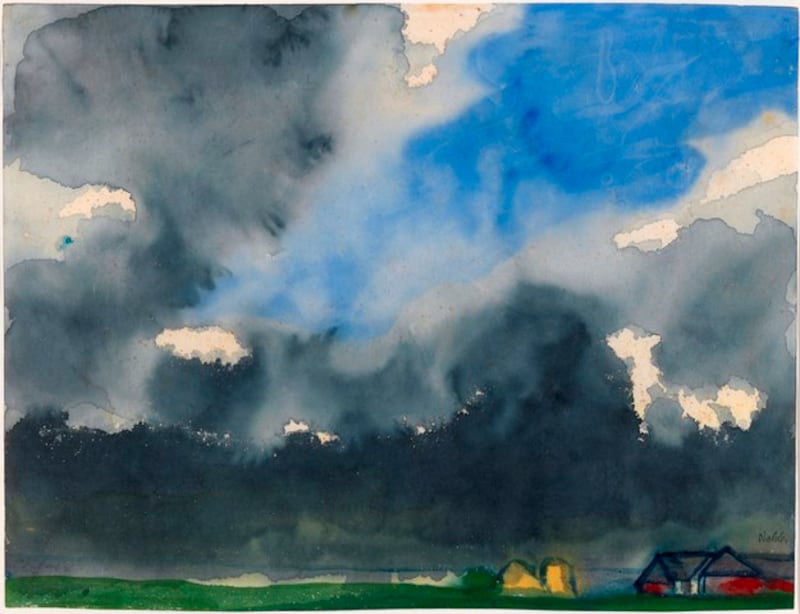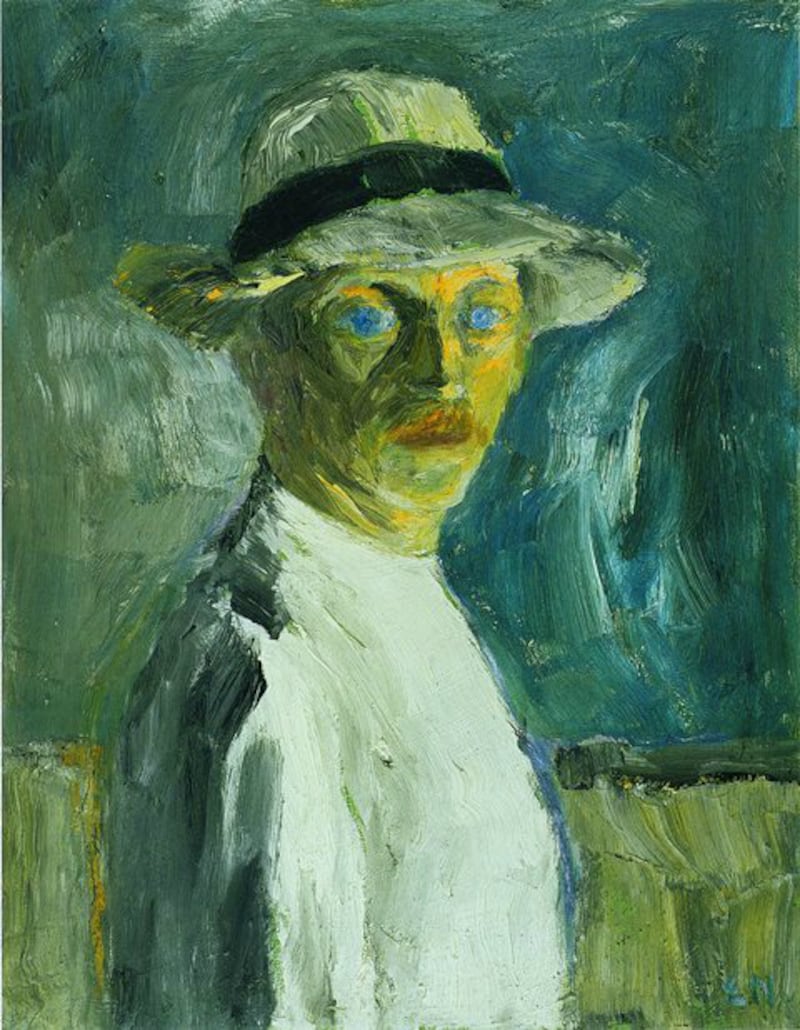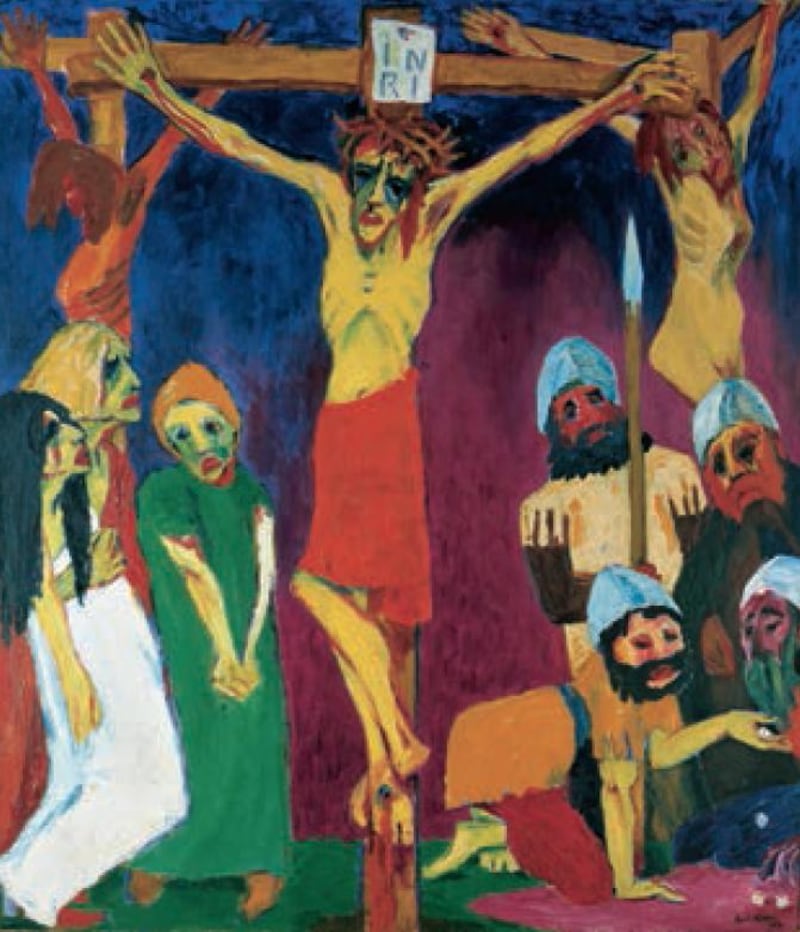Emil Nolde is something of a loner in the history of 20th century European art. Tangentially associated with the German Expressionist group Die Brücke, he backed away from continued involvement. The caricaturish view, which bears some relationship to the truth, is that he was a recluse who lived on the bleak shores of the Baltic and North Seas and made wintry paintings with spiritual overtones such as Blue Day by the Sea, 1940, or Landscape [North Friesland], 1930. He is, though, an indispensible figure in Expressionism, exemplifying in extreme form its core attributes, notably in his uncompromisingly subjective responses to a few basic themes.
The National Gallery of Ireland has an exceptionally good Nolde: Two Women in a Garden, 1915, purchased with the Shaw Fund in 1984. Now the National Gallery of Ireland's exhibition, Emil Nolde: Colour is Life offers a rare opportunity to see by far the largest exhibition of the artist's work ever shown in Ireland. It is a collaborative project with the National Galleries of Scotland and the Nolde Foundation Seebüll, Germany and co-curated by NGI Director Sean Rainbird. The vast majority of the works – more than 130 pieces – come from the incomparable Nolde Foundation collection and span Nolde's creative life.

Nolde was the surname adopted by Emil Hansen when he married Ada Vilstrup in 1902. Vilstrup was Danish and Hansen came from the tiny village of Nolde on the German-Danish border, the sixth child of a German-Fresian father and a Schleswig-Danish mother, born in 1867. The Hansens farmed a difficult, marshy, low-lying terrain; a contested wind-swept region lying between two brimming, restless seas. As Emil's appropriation of the name of his birthplace suggests, he identified with this challenging landscape. His attachment to it and intimate knowledge of it, day by day and season by season, is invested in his many brilliant sea pictures, urgent firsthand accounts of stormy skies and troubled waters, realized with forceful, disconcerting immediacy, as in Rain over a Marsh, of unknown date, or Light Breaking Through, 1950.

Identity
Although he moved on from his birthplace, in time he was drawn back, first to a farmhouse, Utenwarf, and eventually building a modernist house and studio at Seebüll. The location, and his complex relationship with it, inspired him deeply but also posed questions of national and cultural identity. His efforts to deal with those questions cast a long shadow over his life, career and reputation. A crucial moment came when, after the end of the first World War and the Treaty of Versailles, boundaries were redrawn following a plebiscite on the border and his home-place suddenly became part of Denmark. Against his will, Danish citizenship was foisted upon him (see Paradise Lost, 1921). Resenting the physical changes as massive drainage works commenced, Nolde criticized the interference of "foreigners", implicitly rejecting the modernity of Danish initiatives in favour of the ancient, unchanging landscape enshrined in popular, nationalist German notions of Volk and homeland.
By this stage Nolde was a well-established figure in the German art world, with a room in the Nationalgalerie in Berlin permanently devoted to his work. His every statement and decision reinforced his self-identification as German, which in time led him into dangerous territory. Despite his assertive nationalism, he actually felt like a perpetual outsider throughout his life – which may have catalysed that nationalist urge.

One senses he would like to have been accepted as a sophisticated urbanite with a rural background, for example, but he never felt at ease in the city. The mix of local dialects with which he grew up were ill suited to city life in either Denmark or Germany, a problem exacerbated by his strictly religious schooling, which brought with it an antique, biblical grammar of its own.
Woundingly, his speech was mocked by his contemporaries in both Copenhagen, where he struggled to be understood, and Berlin, where Ernst Ludwig Kirchner doubted that he could speak German at all. His intense religiosity manifested itself in two different though related, dominant strands in his work: an ecstatic, often eroticised (as in Ecstasy, 1929), pantheistic absorption in the elemental facts and forces of nature, recalling and reinventing the Romantic tradition (Ruffled Autumn Clouds, 1927, and the grisly Martyrdom triptych, 1921), and a stark, naturalistic treatment of religious subjects (Pharaoh's Daughter Finds Moses, 1910), with a nod to the medieval pictorial tradition that had endured in the work of Northern Renaissance masters like Grünewald. Something of the woodcarver comes through in the blocky, hacked forms of Nolde's figures. Throughout his entire working life, it should be said, he was a brilliant graphic artist, and the show includes many tremendous examples of his graphic work.

Technically, working with oil paint, watercolour or graphic media, he is audacious, trusting to – or rather abandoning himself to – instinct. Instinct is, he wrote "ten times more valuable than knowledge." He was susceptible to the enthusiasm for tribal art that was prevalent among many European artists early in the 20th century, and drew on displays of Oceanic art on display in ethnographic collections: Exotic Figures II, 1911, or Still Life with Masks, 1911. "I have always been fascinated by everything primeval and archaic," as he put it, "The wide, tempestuous sea is still in its original state; the wind, the sun, even the starry sky are virtually the same today as they were fifty thousand years ago."
He and Ada embarked on a voyage to the South Seas in 1913. It was in theory a scientific expedition, but they had no official function. Travelling via Moscow, Siberia, Korea, Japan and China, they eventually visited New Guinea. Gauguin was an inspiration but Nolde didn’t quite follow in his footsteps, nor does he seem to have intended to. War had broken out by the time they returned.
The South Seas
The South Seas provided subject matter (Bay, 1914, is a good example, or South Sea Warriors, also 1914) but didn't decisively alter his vision. From early on, he found French painting too harmonious, even in its post-Impressionist manifestations, including the work of Van Gogh, Matisse, and Gauguin. He was more inclined to contrast and discord. His use of colour is positively explosive and still retains the capacity to startle us. Colours, he wrote, have a life of their own, especially when they were "placed in opposition to each other: cold and warm, light and dark, dull and strong," colours "heralding happiness, passion and love, blood and death." His Candle Dancers, 1912, is a dazzling expression of the abandonment of dancing.
![Large Poppies [Red, red, Red], 1943](https://www.irishtimes.com/resizer/v2/UDOXMRVIEIZFLLQPZZXF7G3YZQ.jpg?auth=5b1977c47b5378c5962d91491117f024f04d8a824058276d0839a6b56d6faeba&width=800&height=623)
Despite his reservations, he still argued that the French had fought the relevant artistic battles of the 1880s and 1890s. Now it was possible for German artists to take the lead, and with reference back to the German old masters – Grünewald, Holbein and Durer. This had partly to do with the opposition of the supposedly introspective, deeply felt art of Northern Europe as opposed to the sensuous, sybaritic South, an art of surface appearances. Even his most lush flower pieces (Trollhois Garden, 1907, or Large Poppies [Red, red, Red], 1943) are a long way from Matisse and Van Gogh in mood. There is something wild and possessed about them. Edvard Munch and James Ensor were clear artistic relations but Nolde really is a loner, artistically.
Apprenticed as a woodcarver and draughtsman in his teens, he worked as a carver in furniture workshops while continuing to study arts and crafts, then found employment at a furniture factory in Berlin for a decade or so. In the 1890s he made a leap to teaching in Switzerland. While there, he produced a series of anthropomorphic images of well known Alpine peaks, including the Matterhorn, each in the guise of a fantastic, imaginary, humanoid creature. Romantic kitsch, as Robert Rosenblum accurately described them, but when they were reproduced as postcards they were runaway bestsellers. An edition of 100,000 sold out. The income gave Nolde the means and confidence to leave his job and become a fulltime artist.

Nolde's Life of Christ, 1911, with its clear references to Grünewald, had pride of place among the 730 works held up to ridicule in the Nazis' exhibition of Degenerate Art in Munich in 1937, bizarrely credited, in the accompanying, deranged, propagandist commentary, to "psychopathic muckrakers and business-savvy Jews". Nolde was in good company: Picasso, Max Beckmann, Marc Chagall, Lovis Corinth, Otto Dix, Paul Klee and Piet Mondrian were among those included. But more than 1,000 of Nolde's works were confiscated by the authorities, which was a record. One can imagine his wounded incomprehension, except that by then he should have had a fair idea of how the Nazis regarded him.
In his own estimation, he had deliberately and carefully positioned himself as championing the cause of German nationalist art, rather than being a modernist or anything else. When the National Socialists came to power in 1933, he thought it augured well for his career. He was a party member and he expected the party to recognise his genius and centrality. There was some basis for his ambition. Goebbels was reputedly well disposed towards the promotion of Expressionism as the official art of Germany, but Hitler loathed the distortions of Expressionism, and that was the end of that.
So self-absorbed, and self-centred, was Nolde that he seems to have been genuinely if unforgivably oblivious of political realities and their terrible human consequences. He applied to join the virulently nationalist, anti-Semitic Militant League for German Culture, but as it transpired they had him in mind as a target rather than a member and rebuffed him. The kinder interpretation is that his political maneuvering seems to have been purely opportunistic rather than motivated by any real ideological conviction, but it still reflects badly on him. He’d opted for German identity and wanted his stance to be recognised and rewarded. He consistently failed to realise that the stakes were far higher than his own petty cultural ambitions.
When Himmler had invited him to the 10th anniversary celebrations of Hitler’s failed 1923 Beer Hall Putsch in Munich, he duly turned up. After being labeled degenerate, he wrote a toadying letter to Goebbels, pointing out his efforts as a champion of National Socialism and offering a self-pitying account of himself as just the kind of German the Nazis loved. By this stage he was over 70. Disdainful of his pleading, the party banned him from exhibiting or selling his work, but he did regain some of his confiscated works and was no longer shamed by being shown with the degenerate artists.

Quiet productions
Although he continued to exhibit in private commercial galleries, after he was denounced by a party functionary in 1941 and was explicitly forbidden from pursuing an artistic career, he retreated to his house at Seebüll and into his own inner world, quietly producing a series of watercolours he referred to as his “unpainted pictures.” Amidst the bureaucratic murk, he continued to sell work through dealers, while still hoping for a change of heart on the part of the authorities. There’s an element of grim, Kafkaesque farce in Nolde’s dogged efforts to persuade the Nazis that he’s one of them, really, while they continually brush him off.
Then, in 1944, he lost a huge cache of his prints, drawings and watercolours, as well as works by other artists in his private collection, when his Berlin apartment was destroyed in a bombing raid. In the aftermath of the war, it was the regime’s documented antagonism towards him that saved him from having to answer awkward questions. He was cleared by the Kiel Denazification Committee, and his artistic reputation and international recognition were quickly restored. The wartime watercolours provided material for his last, prolonged series of oil paintings until about 1951, after which he painted only in watercolour.
Exhibitions and honours flooded in. His wife Ada had died late in 1946, but he remarried within two years. He died, at Seebüll, in April 1956, by which time he was generally regarded as one of the leading German artists of his time, an evaluation that still holds, despite his perverse selfishness and moral failings.
Emil Nolde: Colour is Life Works on loan from the Nolde Foundation Seebüll, Germany. Curated by Janet McLean, Sean Rainbird and Keith Hartley. National Gallery of Ireland, Merrion Square West February 14 – June 10 (Admission charges apply, advance tickets may be available for €5 Booking at nationalgallery.ie)










